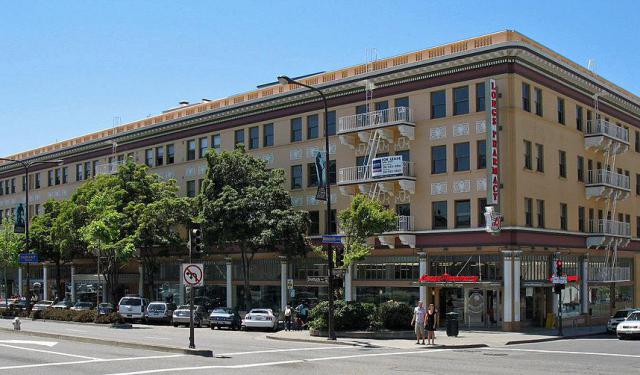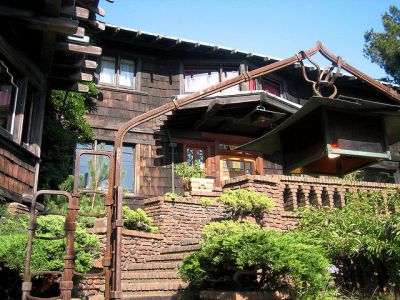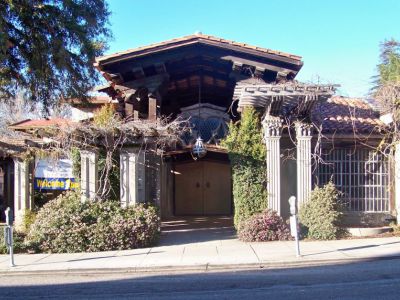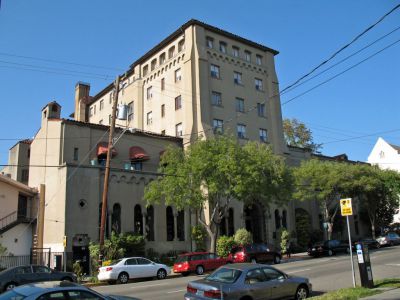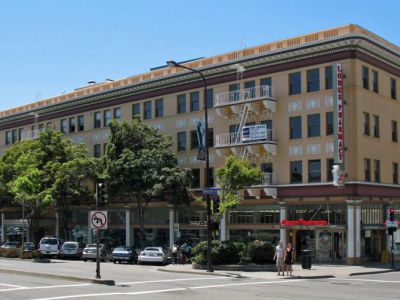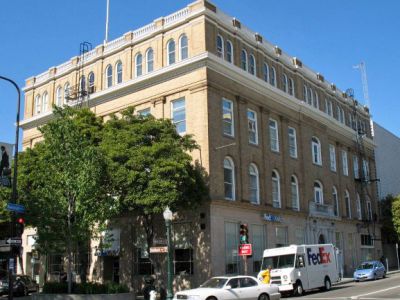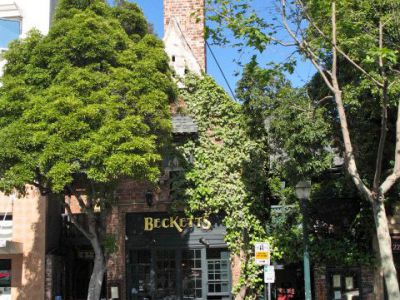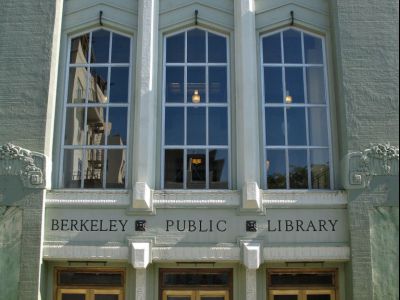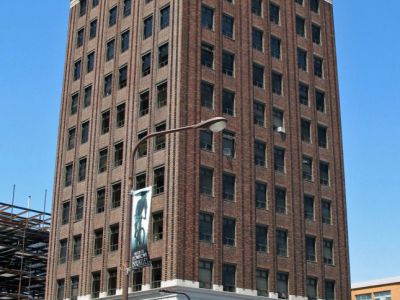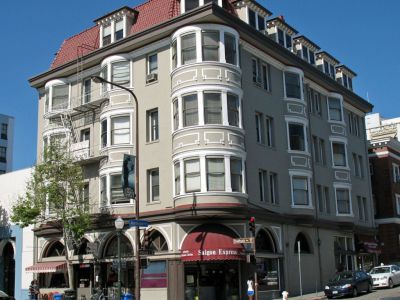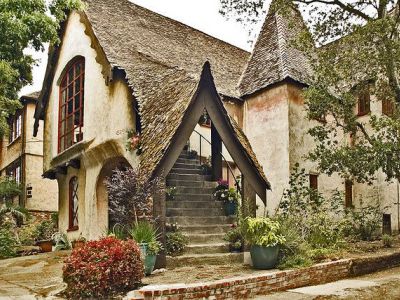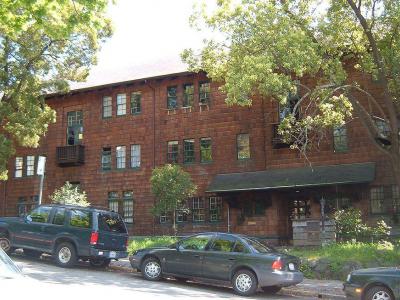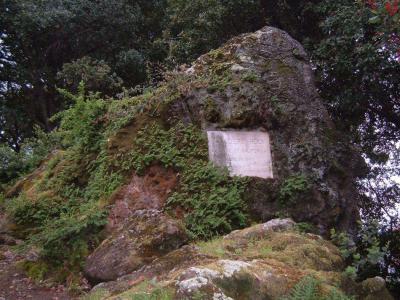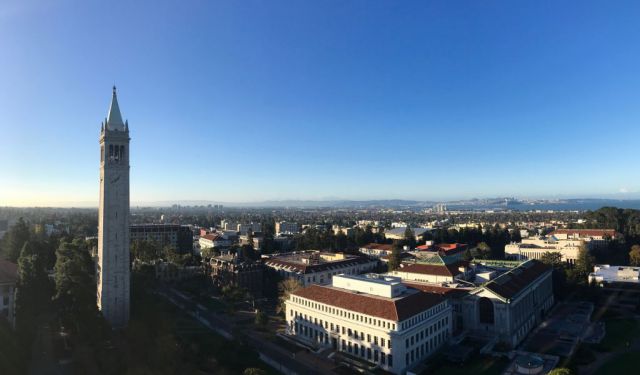Berkeley's Historic Landmarks Walking Tour (Self Guided), Berkeley
Berkeley, California, boasts a fair amount of landmarks distinguished for their historical value and representative of the city’s architectural beauty.
One such gem is the Thorsen House, an iconic residence designed by the renowned architectural firm Greene and Green, showcasing the American Craftsman style.
The First Church of Christ, Scientist, is another notable sight. Its mixed design (a cocktail of American Craftsman, Byzantine Revival, Romanesque Revival, and Gothic Revival elements) is widely considered to be one of the true masterpieces by the renowned local architect Bernard Maybeck. Maybeck was once a mentor for a number of other important California architects, including Julia Morgan and William Wurster.
The Berkeley City Club, designed by Julia Morgan, exudes Mediterranean charm. Originally a women's social club, this building showcases an intricate interpretation of Moorish and Gothic details and today serves as a cultural hub open to all genders.
The Corder Building, Masonic Temple, Tupper and Reed Building, and Chamber of Commerce Building each contribute to the city's historic fabric with their distinct architectural styles, representing various eras of Berkeley's growth.
The Berkeley Public Library, an architectural marvel, offers a wealth of knowledge and community engagement. Meanwhile, the Studio Building is an artistic haven, promoting local creativity.
Thornburg Village, also known as Normandy Village, is a charming residential complex with a unique European flair. Similarly, the Cloyne Court Hotel adds a touch of the Old World historic grandeur to the cityscape.
Founders' Rock symbolizes the birthplace of the University of California, Berkeley, and embodies the city's educational legacy.
In many ways, exploring these locations will reveal to you the heart and soul of Berkeley as a community. We therefore encourage you to visit them, appreciate their beauty, and learn about the history they hold.
One such gem is the Thorsen House, an iconic residence designed by the renowned architectural firm Greene and Green, showcasing the American Craftsman style.
The First Church of Christ, Scientist, is another notable sight. Its mixed design (a cocktail of American Craftsman, Byzantine Revival, Romanesque Revival, and Gothic Revival elements) is widely considered to be one of the true masterpieces by the renowned local architect Bernard Maybeck. Maybeck was once a mentor for a number of other important California architects, including Julia Morgan and William Wurster.
The Berkeley City Club, designed by Julia Morgan, exudes Mediterranean charm. Originally a women's social club, this building showcases an intricate interpretation of Moorish and Gothic details and today serves as a cultural hub open to all genders.
The Corder Building, Masonic Temple, Tupper and Reed Building, and Chamber of Commerce Building each contribute to the city's historic fabric with their distinct architectural styles, representing various eras of Berkeley's growth.
The Berkeley Public Library, an architectural marvel, offers a wealth of knowledge and community engagement. Meanwhile, the Studio Building is an artistic haven, promoting local creativity.
Thornburg Village, also known as Normandy Village, is a charming residential complex with a unique European flair. Similarly, the Cloyne Court Hotel adds a touch of the Old World historic grandeur to the cityscape.
Founders' Rock symbolizes the birthplace of the University of California, Berkeley, and embodies the city's educational legacy.
In many ways, exploring these locations will reveal to you the heart and soul of Berkeley as a community. We therefore encourage you to visit them, appreciate their beauty, and learn about the history they hold.
How it works: Download the app "GPSmyCity: Walks in 1K+ Cities" from Apple App Store or Google Play Store to your mobile phone or tablet. The app turns your mobile device into a personal tour guide and its built-in GPS navigation functions guide you from one tour stop to next. The app works offline, so no data plan is needed when traveling abroad.
Berkeley's Historic Landmarks Walking Tour Map
Guide Name: Berkeley's Historic Landmarks Walking Tour
Guide Location: USA » Berkeley (See other walking tours in Berkeley)
Guide Type: Self-guided Walking Tour (Sightseeing)
# of Attractions: 12
Tour Duration: 3 Hour(s)
Travel Distance: 4.5 Km or 2.8 Miles
Author: AudreyB
Sight(s) Featured in This Guide:
Guide Location: USA » Berkeley (See other walking tours in Berkeley)
Guide Type: Self-guided Walking Tour (Sightseeing)
# of Attractions: 12
Tour Duration: 3 Hour(s)
Travel Distance: 4.5 Km or 2.8 Miles
Author: AudreyB
Sight(s) Featured in This Guide:
- Thorsen House
- First Church of Christ, Scientist
- Berkeley City Club
- Corder Building
- Masonic Temple
- Tupper and Reed Building
- Berkeley Public Library
- Chamber of Commerce Building
- Studio Building
- Thornburg Village (Normandy Village)
- Cloyne Court Hotel
- Founders' Rock
1) Thorsen House
Greene and Greene was an architectural firm that held lofty influence over design styles of the early 20th century. One of their unique styles was that of the "ultimate bungalow." These homes use tropical woods, leaded art glass, mother of pearl and metal accents in an arts and crafts style. There are only four of these ultimate bungalows still standing. One is the Thorsen House.
The home was built in 1909 for lumber baron William Thorsen and his wife Caroline. Both of the Thorsens died in 1942. After that time, the home came under ownership of the Sigma Phi Society. The fraternity is tasked with keeping the house updated and continuously restored. The brothers are also required to know the history of the home and its architecture so that they can provide guided tours when needed.
Thorsen House is located near Memorial Stadium on Bancroft Way and Piedmont Avenue. Visitors are welcome, though the Sigma Phi Society does request that tours be scheduled in advance.
The home was built in 1909 for lumber baron William Thorsen and his wife Caroline. Both of the Thorsens died in 1942. After that time, the home came under ownership of the Sigma Phi Society. The fraternity is tasked with keeping the house updated and continuously restored. The brothers are also required to know the history of the home and its architecture so that they can provide guided tours when needed.
Thorsen House is located near Memorial Stadium on Bancroft Way and Piedmont Avenue. Visitors are welcome, though the Sigma Phi Society does request that tours be scheduled in advance.
2) First Church of Christ, Scientist (must see)
The First Church of Scientist is located near People's Park in downtown Berkeley. The church building was constructed in 1910 using elements from multiple architectural styles. The building displays influences from Byzantine Revival, Romanesque Revival and Gothic Revival architecture.
The church was designed by Bernard Maybeck who was an architect and instructor at UC Berkeley. This church is considered one of his great masterpieces alongside the Palace of Fine Arts in San Francisco.
The plan of the church is that of a Greek Cross. Two pairs of crossed trusses with gilt inlays span the interior. There are also a number of Roman arches, unique tiles and industrial steel sashes over the windows. Visitors are welcome to tour the church interior. They may also attend worship services, which take place every Sunday.
Due to its location on the corner of Bowditch Street and Dwight Way, it is very easy for visitors to admire the building's architecture. From street level, tourists can see the hammered Belgian glass of the windows and the carved reliefs that top the exterior columns. They will also be able to pinpoint the Japanese influences that are apparent in the courtyard rooftops and the portal to the Sunday School wing.
The First Church of Christ, Scientist is on the National Register of Historic Places. It was declared a National Historic Landmark in 1977. Preservation and restoration of the church is managed by the Friends of First Church.
Why You Should Visit:
- To see what many consider to be Bernard Maybeck's greatest masterpiece.
- To appreciate the blending of various architectural styles in one place.
Tips:
Free tours of the First Church of Christ, Scientist are available the first Sunday of every month.
The church was designed by Bernard Maybeck who was an architect and instructor at UC Berkeley. This church is considered one of his great masterpieces alongside the Palace of Fine Arts in San Francisco.
The plan of the church is that of a Greek Cross. Two pairs of crossed trusses with gilt inlays span the interior. There are also a number of Roman arches, unique tiles and industrial steel sashes over the windows. Visitors are welcome to tour the church interior. They may also attend worship services, which take place every Sunday.
Due to its location on the corner of Bowditch Street and Dwight Way, it is very easy for visitors to admire the building's architecture. From street level, tourists can see the hammered Belgian glass of the windows and the carved reliefs that top the exterior columns. They will also be able to pinpoint the Japanese influences that are apparent in the courtyard rooftops and the portal to the Sunday School wing.
The First Church of Christ, Scientist is on the National Register of Historic Places. It was declared a National Historic Landmark in 1977. Preservation and restoration of the church is managed by the Friends of First Church.
Why You Should Visit:
- To see what many consider to be Bernard Maybeck's greatest masterpiece.
- To appreciate the blending of various architectural styles in one place.
Tips:
Free tours of the First Church of Christ, Scientist are available the first Sunday of every month.
3) Berkeley City Club
The Berkeley City Club, located on Durant Avenue in Berkeley, is a historic gem that seamlessly blends Moorish and Gothic architectural styles. Originally commissioned in 1927 as the clubhouse for the Berkeley Women’s City Club, it was designed to foster social, civic, and cultural progress. The building, completed in 1929 and officially opened in 1930, was the brainchild of Julia Morgan, the trailblazing architect renowned for her work on Hearst Castle and for being the first licensed female architect in California. Her design for the Berkeley City Club earned it the nickname “Little Castle.”
The property, now a California Historical Landmark and listed on the National Register of Historic Places, has evolved into a multifaceted venue. Open to all genders since 1963, it serves as a hotel, event space, and fine dining destination. The second floor is home to Julia’s Restaurant and Morgan’s Bar & Lounge, offering a refined culinary experience in a historic setting.
Morgan’s signature design is evident throughout, with features such as vaulted ceilings, carved archways, leaded glass windows, and lush courtyards providing a tranquil retreat amidst Berkeley’s urban energy. The Berkeley City Club Conservancy oversees the building’s preservation, ensuring its legacy as a cultural and architectural landmark. Whether visiting for an overnight stay, a wedding, or simply to admire the architecture, the Berkeley City Club offers a timeless experience steeped in history and elegance.
The property, now a California Historical Landmark and listed on the National Register of Historic Places, has evolved into a multifaceted venue. Open to all genders since 1963, it serves as a hotel, event space, and fine dining destination. The second floor is home to Julia’s Restaurant and Morgan’s Bar & Lounge, offering a refined culinary experience in a historic setting.
Morgan’s signature design is evident throughout, with features such as vaulted ceilings, carved archways, leaded glass windows, and lush courtyards providing a tranquil retreat amidst Berkeley’s urban energy. The Berkeley City Club Conservancy oversees the building’s preservation, ensuring its legacy as a cultural and architectural landmark. Whether visiting for an overnight stay, a wedding, or simply to admire the architecture, the Berkeley City Club offers a timeless experience steeped in history and elegance.
4) Corder Building
The Corder Building, located at the corner of Shattuck Avenue and Bancroft Way in downtown Berkeley, stands as a remarkable example of Classical Revival architecture. Designed by prominent architect James W. Plachek, the structure was completed in 1921 and has since become a significant landmark in the city. It was added to the National Register of Historic Places on January 11, 1982, and is also recognized as a City of Berkeley Landmark.
The building's elegant sand-colored facade, adorned with white columns and balconies, exudes sophistication and urban dignity, a defining characteristic of Plachek’s work. The Corder Building played a pivotal role in shaping Berkeley’s downtown, transforming a previously empty block into a cohesive part of the burgeoning business district. Its construction marked a major step forward in merging smaller historic business areas into one continuous downtown core.
Originally built as a multi-use structure, the ground floor now houses a pharmacy, while the upper floors have been repurposed into the Shattuck Apartments. A recent restoration preserved the building's historic facade and enhanced its usability with seismic upgrades, new storefronts, tile bulkheads, and a more vibrant exterior color scheme. Modern updates include the installation of new elevator lobbies, tenant demising walls, and a prominent canopy between the Bancroft Way entrance and the annex.
The Corder Building remains a testament to Plachek's vision and Berkeley’s rich architectural heritage, bridging the past and present with its enduring elegance and functionality.
The building's elegant sand-colored facade, adorned with white columns and balconies, exudes sophistication and urban dignity, a defining characteristic of Plachek’s work. The Corder Building played a pivotal role in shaping Berkeley’s downtown, transforming a previously empty block into a cohesive part of the burgeoning business district. Its construction marked a major step forward in merging smaller historic business areas into one continuous downtown core.
Originally built as a multi-use structure, the ground floor now houses a pharmacy, while the upper floors have been repurposed into the Shattuck Apartments. A recent restoration preserved the building's historic facade and enhanced its usability with seismic upgrades, new storefronts, tile bulkheads, and a more vibrant exterior color scheme. Modern updates include the installation of new elevator lobbies, tenant demising walls, and a prominent canopy between the Bancroft Way entrance and the annex.
The Corder Building remains a testament to Plachek's vision and Berkeley’s rich architectural heritage, bridging the past and present with its enduring elegance and functionality.
5) Masonic Temple
The Masonic Temple in Downtown Berkeley is a landmark of historical and architectural significance. Located on Bancroft Way, at the corner of Shattuck Avenue, it stands just a block west of the University of California, Berkeley. Designed in 1905 by William H. Wharff, a prominent architect who helped define Berkeley’s early brick classical downtown style, the building is one of the earliest multi-storied brick structures that replaced the city’s pioneer wooden business district in the early 20th century. Remarkably, it remains largely unaltered and is the only surviving example of Wharff's contributions to the era.
Originally constructed for Berkeley's Masons, who established a local lodge in 1882, the temple served as their headquarters for decades. The Berkeley Masonic Temple Association was formed specifically to bring this project to life. In 1944, the building was repurposed as a bank, and in subsequent years, its floors hosted various University of California-related tenants, including the California Center for Innovative Transportation and the National Writing Project.
Listed on the National Register of Historic Places since July 15, 1982, the building underwent a full renovation in 2019, which modernized its facilities while retaining its historic charm. As of 2023, the ground floor is partially occupied by a yoga studio, while the second floor houses the Haas School of Business. The third and fourth floors were occupied by Grabango, a local tech startup specializing in frictionless checkout technology, until March 2024.
The Masonic Temple is a testament to Berkeley's architectural evolution and its commitment to preserving its historical roots amidst modern developments.
Originally constructed for Berkeley's Masons, who established a local lodge in 1882, the temple served as their headquarters for decades. The Berkeley Masonic Temple Association was formed specifically to bring this project to life. In 1944, the building was repurposed as a bank, and in subsequent years, its floors hosted various University of California-related tenants, including the California Center for Innovative Transportation and the National Writing Project.
Listed on the National Register of Historic Places since July 15, 1982, the building underwent a full renovation in 2019, which modernized its facilities while retaining its historic charm. As of 2023, the ground floor is partially occupied by a yoga studio, while the second floor houses the Haas School of Business. The third and fourth floors were occupied by Grabango, a local tech startup specializing in frictionless checkout technology, until March 2024.
The Masonic Temple is a testament to Berkeley's architectural evolution and its commitment to preserving its historical roots amidst modern developments.
6) Tupper and Reed Building
The Tupper and Reed Building was erected in 1925 in a storybook house style designed by architect William Yellend. The building was built for music store owners John C. Tupper and Lawrence Reed. The Tupper and Reed Music Store was a mainstay in Berkeley for nearly a century; finally closing its doors in 2005.
Though the music store is now gone, the building does not remain vacant. It is now known as the Tupper & Reed Cocktail Bar. Visitors can stop in and have a drink, listen to music or simply enjoy the unique design of this now urban hotspot.
The original music store also included a performance space and a restaurant on the top floor. That restaurant was called the Sign of the Piper. A remnant of that restaurant can be seen through the image of the Pied Piper that located atop the chimney.
The Tupper and Reed Building is located on historic Shattuck Avenue near the University of California Berkeley campus.
Though the music store is now gone, the building does not remain vacant. It is now known as the Tupper & Reed Cocktail Bar. Visitors can stop in and have a drink, listen to music or simply enjoy the unique design of this now urban hotspot.
The original music store also included a performance space and a restaurant on the top floor. That restaurant was called the Sign of the Piper. A remnant of that restaurant can be seen through the image of the Pied Piper that located atop the chimney.
The Tupper and Reed Building is located on historic Shattuck Avenue near the University of California Berkeley campus.
7) Berkeley Public Library
The Berkeley Public Library serves as the public library system for Berkeley and includes a Central Library, four neighborhood branches (Claremont, North, West, and Tarea Hill Pittman South), and the innovative Tool Lending Library-one of the first in the nation.
Founded in 1893 on Shattuck Avenue with a modest collection of 264 books, the library quickly grew to accommodate the needs of its community. By 1905, it had relocated to a new Carnegie-funded building on Kittredge Street, on land donated by Rosa M. Shattuck. The 1906 San Francisco earthquake spurred a population influx to Berkeley, leading to the establishment of additional branches to better serve the city.
The Central Library, an architectural masterpiece designed by James W. Plachek, opened in 1931 following a complete redesign and reconstruction. The building exemplifies the Zig Zag Moderne style, with its innovative use of materials, efficient construction techniques, and artistic details. Its significance lies not only in its architectural beauty but also in its harmonious integration with surrounding civic structures and its exceptional preservation. A 2002 renovation ensured its continued relevance, blending historic charm with modern functionality.
Between 2011 and 2013, the library system underwent a comprehensive renovation and expansion of its branches. The Claremont and North Branches were completed in 2012, while the South Branch and Tool Lending Library reopened in May 2013. The West Branch followed in December 2013. During construction, the library utilized a mobile service, the Branch Van, to provide continued access to books and resources for local neighborhoods.
Today, the Berkeley Public Library stands as a symbol of civic pride, community engagement, and innovative library services. Its rich history and ongoing commitment to accessibility and preservation make it a cornerstone of Berkeley's cultural and educational landscape.
Founded in 1893 on Shattuck Avenue with a modest collection of 264 books, the library quickly grew to accommodate the needs of its community. By 1905, it had relocated to a new Carnegie-funded building on Kittredge Street, on land donated by Rosa M. Shattuck. The 1906 San Francisco earthquake spurred a population influx to Berkeley, leading to the establishment of additional branches to better serve the city.
The Central Library, an architectural masterpiece designed by James W. Plachek, opened in 1931 following a complete redesign and reconstruction. The building exemplifies the Zig Zag Moderne style, with its innovative use of materials, efficient construction techniques, and artistic details. Its significance lies not only in its architectural beauty but also in its harmonious integration with surrounding civic structures and its exceptional preservation. A 2002 renovation ensured its continued relevance, blending historic charm with modern functionality.
Between 2011 and 2013, the library system underwent a comprehensive renovation and expansion of its branches. The Claremont and North Branches were completed in 2012, while the South Branch and Tool Lending Library reopened in May 2013. The West Branch followed in December 2013. During construction, the library utilized a mobile service, the Branch Van, to provide continued access to books and resources for local neighborhoods.
Today, the Berkeley Public Library stands as a symbol of civic pride, community engagement, and innovative library services. Its rich history and ongoing commitment to accessibility and preservation make it a cornerstone of Berkeley's cultural and educational landscape.
8) Chamber of Commerce Building
The Chamber of Commerce Building was notable as Berkeley's first high rise. The 12-story brick and terra cotta building was designed by architect Walter H. Ratcliff, Jr., who was Berkeley's first City Architect.
The building, completed in 1927, was named after the Chamber of Commerce due to the fact that the Chamber occupied the top floor. For many years, the building housed the American Trust Company. Today, it is home to Wells Fargo Bank.
The Central Berkeley Building Company funded the construction of the Chamber of Commerce Building in part to influence the state government to move the capital from Sacramento to Berkeley. The ploy was partially successful. The legislature placed the motion on a ballot in 1908. The voters chose against the move.
The Chamber of Commerce Building is on the National Register of Historic Places. Despite restorations over the years, the building is almost entirely original. The only significant changes were to the roof sign, which was removed in 1962, and the wood storefront that was replaced with bronze anodized aluminum in 1978.
The building, completed in 1927, was named after the Chamber of Commerce due to the fact that the Chamber occupied the top floor. For many years, the building housed the American Trust Company. Today, it is home to Wells Fargo Bank.
The Central Berkeley Building Company funded the construction of the Chamber of Commerce Building in part to influence the state government to move the capital from Sacramento to Berkeley. The ploy was partially successful. The legislature placed the motion on a ballot in 1908. The voters chose against the move.
The Chamber of Commerce Building is on the National Register of Historic Places. Despite restorations over the years, the building is almost entirely original. The only significant changes were to the roof sign, which was removed in 1962, and the wood storefront that was replaced with bronze anodized aluminum in 1978.
9) Studio Building
The Studio Building, located on Shattuck Avenue in Berkeley, is a historic landmark with a rich and artistic heritage. Built in 1905, it was one of Berkeley's earliest masonry structures and, for a brief time, the tallest building in downtown. This distinction was short-lived, as the Shattuck Hotel surpassed its height in 1909. The building’s construction marked a shift from the predominance of wood-frame architecture in the area.
Commissioned by Frederick H. Dakin, a real estate investor with interests in gold mining, the building’s design is often attributed to his architect son, Clarence Dakin, or possibly his architect niece, Edna Deakin. Its artistic legacy is underscored by the fact that its fifth floor was originally dedicated to artists' studios and galleries. A large tile mosaic of an artist’s palette, designed by Frederick’s brother, the renowned artist Edwin Deakin, adorns the building's entrance.
Notable for its five-story masonry structure, the building features a distinctive tiled mansard roof and rounded upper-floor window bays. Originally, the first-floor shopfronts were framed by a series of alternating rounded and pointed arches, some of which have since been modified.
The Studio Building was central to Berkeley’s cultural growth, hosting its first art exhibit in 1906 and becoming the founding site of the California College of the Arts in 1907. Early tenants included architect John Hudson Thomas, painters Henry J. Breuer and Evelyn A. Withrow, and photographers Oscar Maurer and Edwin James McCullagh. A performing arts school opened there in 1910.
For much of the 20th century, the building functioned as the Berkeley Hotel. It underwent restoration in the late 1970s and was designated a City of Berkeley Landmark and added to the National Register of Historic Places in 1978. Today, the Studio Building stands as a testament to Berkeley’s architectural innovation and vibrant artistic history.
Commissioned by Frederick H. Dakin, a real estate investor with interests in gold mining, the building’s design is often attributed to his architect son, Clarence Dakin, or possibly his architect niece, Edna Deakin. Its artistic legacy is underscored by the fact that its fifth floor was originally dedicated to artists' studios and galleries. A large tile mosaic of an artist’s palette, designed by Frederick’s brother, the renowned artist Edwin Deakin, adorns the building's entrance.
Notable for its five-story masonry structure, the building features a distinctive tiled mansard roof and rounded upper-floor window bays. Originally, the first-floor shopfronts were framed by a series of alternating rounded and pointed arches, some of which have since been modified.
The Studio Building was central to Berkeley’s cultural growth, hosting its first art exhibit in 1906 and becoming the founding site of the California College of the Arts in 1907. Early tenants included architect John Hudson Thomas, painters Henry J. Breuer and Evelyn A. Withrow, and photographers Oscar Maurer and Edwin James McCullagh. A performing arts school opened there in 1910.
For much of the 20th century, the building functioned as the Berkeley Hotel. It underwent restoration in the late 1970s and was designated a City of Berkeley Landmark and added to the National Register of Historic Places in 1978. Today, the Studio Building stands as a testament to Berkeley’s architectural innovation and vibrant artistic history.
10) Thornburg Village (Normandy Village)
Thornberg Village, also known as Normandy Village, is a residential neighborhood at Spruce Street and Hearst Avenue. The village was the brainchild of Jack Wood Thornburg. The 25-year old had already constructed a number of buildings in the area in storybook style. His next venture was to create a self-contained neighborhood using French-Norman, Scandinavian and Mediterranean influences.
The goal was to build an area that consisted of homes, shops and restaurants, all with the old-world style of brick and stone facades, steep gables, tower rooms and turrets. Unfortunately for Thornburg, zoning prevented him from achieving the commercial goals he desired. Instead, each of the units became residential spots where locals have continuously owned and rented room since the area was completed in 1927.
Tourists can walk through Thornburg Village to see homes that appear as though they have transported themselves directly from the pages of a European storybook. The interiors cannot be viewed by the public as they are private homes, but it is easy to imagine the stone walls, oak floors and beamed ceilings that are held within.
Not all of Thornburg Village is original. The area was expanded once in 1928 and again in 1955. There are now parking structures for the residents, but these are hidden from street view so as not to distract from the overall appearance.
Thornburg Village was declared a Berkeley Historical Landmark in 1983.
Why You Should Visit:
- To take a step into old-world Europe without leaving the United States
- To admire residential areas that are nearly a century old
Tips:
These private homes are currently occupied. Therefore, visitors should make sure they are respectful of the property during their visit.
The goal was to build an area that consisted of homes, shops and restaurants, all with the old-world style of brick and stone facades, steep gables, tower rooms and turrets. Unfortunately for Thornburg, zoning prevented him from achieving the commercial goals he desired. Instead, each of the units became residential spots where locals have continuously owned and rented room since the area was completed in 1927.
Tourists can walk through Thornburg Village to see homes that appear as though they have transported themselves directly from the pages of a European storybook. The interiors cannot be viewed by the public as they are private homes, but it is easy to imagine the stone walls, oak floors and beamed ceilings that are held within.
Not all of Thornburg Village is original. The area was expanded once in 1928 and again in 1955. There are now parking structures for the residents, but these are hidden from street view so as not to distract from the overall appearance.
Thornburg Village was declared a Berkeley Historical Landmark in 1983.
Why You Should Visit:
- To take a step into old-world Europe without leaving the United States
- To admire residential areas that are nearly a century old
Tips:
These private homes are currently occupied. Therefore, visitors should make sure they are respectful of the property during their visit.
11) Cloyne Court Hotel
The Cloyne Court Hotel, commonly known as Cloyne, is a historic gem nestled on the north side of the University of California, Berkeley campus on Ridge Road. This landmark, a testament to early 20th-century architecture and community, now operates as one of the houses within the Berkeley Student Cooperative (BSC), the largest student housing cooperative in North America.
Built in 1904 by the University Land and Improvement Company, Cloyne Court was designed by architect John Galen Howard. It was named after Cloyne, a village in Ireland where philosopher George Berkeley served as bishop. Originally a “high-class, modern apartment house,” the building featured 32 suites, each equipped with a private bath, and individual telephone wiring, and separated by fireproof walls. Its innovative layout eschewed common hallways for private stairways connecting suites to public spaces.
The Pierce family managed Cloyne until 1946 when it was sold to the University Students' Cooperative Association (now BSC). Initially an all-male residence hosting social events with nearby women's co-ops, it became coeducational in 1972. In 1970, ownership transferred to the Regents of the University of California under threat of eminent domain, and it now operates under a peppercorn lease renewed in 2005.
Today, Cloyne houses 140 UC Berkeley students (119 during summer), primarily undergraduates, and operates as a fully student-run and student-governed residence. Members contribute five hours of work per week, performing tasks like cooking, cleaning, and maintenance. Communal meals and weekly meetings foster a sense of community and shared responsibility.
Cloyne was designated a City of Berkeley Landmark in 1982 and added to the National Register of Historic Places in 1992. The building remains a vibrant part of Berkeley’s landscape, blending its storied past with a commitment to cooperative living and student empowerment.
Built in 1904 by the University Land and Improvement Company, Cloyne Court was designed by architect John Galen Howard. It was named after Cloyne, a village in Ireland where philosopher George Berkeley served as bishop. Originally a “high-class, modern apartment house,” the building featured 32 suites, each equipped with a private bath, and individual telephone wiring, and separated by fireproof walls. Its innovative layout eschewed common hallways for private stairways connecting suites to public spaces.
The Pierce family managed Cloyne until 1946 when it was sold to the University Students' Cooperative Association (now BSC). Initially an all-male residence hosting social events with nearby women's co-ops, it became coeducational in 1972. In 1970, ownership transferred to the Regents of the University of California under threat of eminent domain, and it now operates under a peppercorn lease renewed in 2005.
Today, Cloyne houses 140 UC Berkeley students (119 during summer), primarily undergraduates, and operates as a fully student-run and student-governed residence. Members contribute five hours of work per week, performing tasks like cooking, cleaning, and maintenance. Communal meals and weekly meetings foster a sense of community and shared responsibility.
Cloyne was designated a City of Berkeley Landmark in 1982 and added to the National Register of Historic Places in 1992. The building remains a vibrant part of Berkeley’s landscape, blending its storied past with a commitment to cooperative living and student empowerment.
12) Founders' Rock (must see)
Founders' Rock, located at the corner of Hearst Avenue and Gayley Road in Berkeley, is a historical landmark closely tied to the origins of the University of California. This natural geological outcropping marks the spot where, on April 16, 1860, the trustees of the College of California gathered to dedicate the newly acquired 30-acre property as the future site for their college. This moment laid the groundwork for what would later become the University of California in 1868.
The rock also holds significant cultural importance. In 1866, Frederick H. Billings, inspired by Bishop George Berkeley's verse, "Westward the course of empire takes its way," suggested naming the surrounding area "Berkeley." This poetic choice forever linked the college and city to the philosopher's legacy.
The graduating class of 1896 commemorated this historic site by placing a plaque on Founders' Rock during Charter Day celebrations. Over the years, it has been recognized as a Berkeley Landmark (since 1991), a California Historical Landmark (since 1982), and part of the National Register of Historic Places (since 1982). Its unique geological composition may owe its prominence to ancient seismic activity from the nearby Hayward Fault.
Founders' Rock serves as a tangible reminder of the University of California's early history and the visionary efforts that shaped one of the world’s premier institutions of higher learning.
The rock also holds significant cultural importance. In 1866, Frederick H. Billings, inspired by Bishop George Berkeley's verse, "Westward the course of empire takes its way," suggested naming the surrounding area "Berkeley." This poetic choice forever linked the college and city to the philosopher's legacy.
The graduating class of 1896 commemorated this historic site by placing a plaque on Founders' Rock during Charter Day celebrations. Over the years, it has been recognized as a Berkeley Landmark (since 1991), a California Historical Landmark (since 1982), and part of the National Register of Historic Places (since 1982). Its unique geological composition may owe its prominence to ancient seismic activity from the nearby Hayward Fault.
Founders' Rock serves as a tangible reminder of the University of California's early history and the visionary efforts that shaped one of the world’s premier institutions of higher learning.
Walking Tours in Berkeley, California
Create Your Own Walk in Berkeley
Creating your own self-guided walk in Berkeley is easy and fun. Choose the city attractions that you want to see and a walk route map will be created just for you. You can even set your hotel as the start point of the walk.
University of California in Berkeley Walking Tour
The University of California, Berkeley, often referred to as UC Berkeley or simply Berkeley, is a part of the larger University of California system, known for its distinguished academics and vibrant campus life. The UC Berkeley campus is the core of Berkeley's attractions. Its design resulted from an 1898 architectural competition, with each building having its own story to tell.
Start... view more
Tour Duration: 2 Hour(s)
Travel Distance: 3.1 Km or 1.9 Miles
Start... view more
Tour Duration: 2 Hour(s)
Travel Distance: 3.1 Km or 1.9 Miles
Telegraph Avenue Shopping
In addition to other attractions, the colorful and joyful city of Berkeley, California offers a wide variety of places to shop. Perhaps the most notable among them is Telegraph Avenue, a vibrant and eclectic thoroughfare, featuring a unique blend of cultural diversity and youthful energy.
One of the standout landmarks on Telegraph Avenue is the Berkeley Hat Company. Here, you'll find an... view more
Tour Duration: 1 Hour(s)
Travel Distance: 0.6 Km or 0.4 Miles
One of the standout landmarks on Telegraph Avenue is the Berkeley Hat Company. Here, you'll find an... view more
Tour Duration: 1 Hour(s)
Travel Distance: 0.6 Km or 0.4 Miles
Berkeley Introduction Walking Tour
The Ohlone people were the original inhabitants of the area that is now known as Berkeley, California. Many of them were casualties of the presence of the first settlers of European descent who arrived with the De Anza Expedition of 1776.
Among the soldiers in this expedition was Luis Peralta, who was gifted the land that would become Berkeley by the King of Spain. Peralta gifted the land to... view more
Tour Duration: 2 Hour(s)
Travel Distance: 2.3 Km or 1.4 Miles
Among the soldiers in this expedition was Luis Peralta, who was gifted the land that would become Berkeley by the King of Spain. Peralta gifted the land to... view more
Tour Duration: 2 Hour(s)
Travel Distance: 2.3 Km or 1.4 Miles
The Most Popular Cities
/ view all
